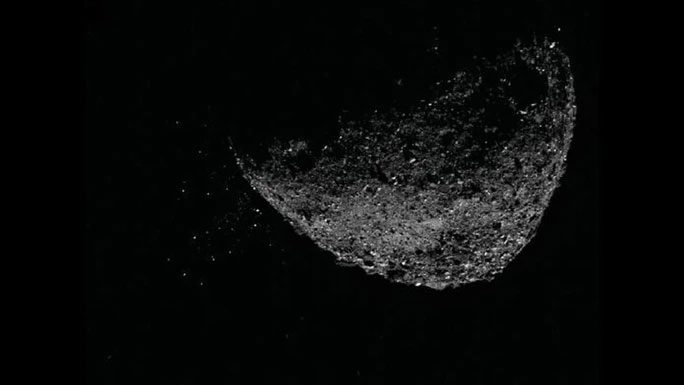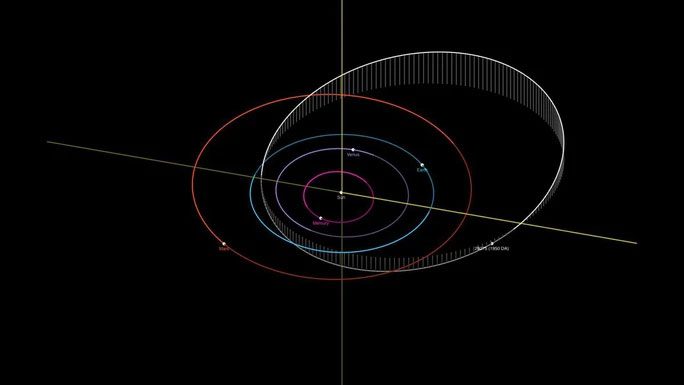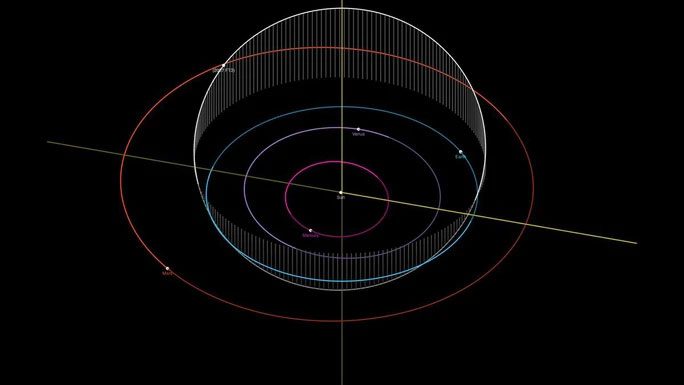The top dangerous objects are closely monitored by the Sentry system of the Center for Near Earth Object Studies (CNEOS) under NASA, which includes some very familiar names.
The Live Science report highlights the 5 most dangerous space objects that could pose a threat to Earth similar to the Chicxulub asteroid, which triggered the mass extinction that wiped out the dinosaurs, as noted by Sentry.
1. Bennu
Bennu is the asteroid from which NASA’s OSIRIS-REx spacecraft collected samples and subsequently released about 250 grams of material back to Earth at the end of September.

Asteroid Bennu – (Photo: NASA).
This asteroid has an average width of 0.49 km and a mass of 74 million tons.
It tops the list of asteroids with a potential risk of colliding with Earth, with a probability of impact on September 24, 2182, estimated at 1 in 2,700. Although this ratio seems low, it poses a significant threat as a collision with Bennu would unleash energy equivalent to the explosion of 1.4 billion tons of TNT.
This is also why NASA invests in research about it, including sample collection.
2. 29075 (1950 DA)
The second asteroid on the list went missing for 50 years after its initial discovery in 1950, before reappearing unexpectedly. It has a width of 1.3 km and a mass of 78 million tons.

The orbit of 29075 (in white) crosses several planets in the Solar System – (Photo: NASA)
Its probability of collision is 1 in 34,500 on March 16, 2880, with an energy release equivalent to 75 billion tons of TNT, which could trigger a series of disasters sufficient to cause human extinction.
3. 2023 TL4
Discovered in 2023, this object, which is 0.33 km wide and weighs 47 million tons, is estimated to have a probability of 1 in 181,000 to strike Earth on October 10, 2119, releasing energy equivalent to the explosion of 7.5 billion tons of TNT.
4. FT3 2007
With a width of 0.34 km and a mass of 54 million tons, it could release energy equivalent to the explosion of 2.6 billion tons of TNT, enough to cause catastrophic extinction in many regions around the world if it were to collide.
The probability of impact for this object is 1 in 10 million on March 3, 2030.

The orbit of FT3 2007 (in white) – (Photo: NASA).
5. 1979 XB
This asteroid vanished 40 years after its discovery in 1979, so its orbit is still not completely understood.
However, what NASA has indicates that the asteroid, which is 0.66 km wide and weighs 390 million tons, is at risk of impacting Earth on December 14, 2113, releasing energy equivalent to 30 billion tons of TNT.
NASA assures that there are currently no objects expected to have a “significant impact” on the planet in the next 100 years.
This space agency, along with other partners around the world, continues to work on missions to identify threats and develop methods to directly impact dangerous asteroids, similar to the DART experiment in 2022.
The “Underdog” 99942 Apophis
With a width of 0.34 km and weighing 27 million tons, this mysterious asteroid topped the list for two decades before “dropping in rank.” Initially, it was thought to pose a threat to Earth in 2036 or 2068.
However, new calculations show that 99942 Apophis is unlikely to pose a danger for at least the next 100 years and it has now been removed from NASA’s “watch list.”




















































